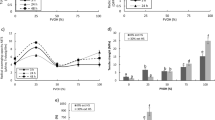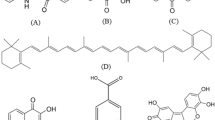Abstract
This paper reports results of an investigation of the effects of different parameters used in the antimicrobial finishing process on rechargeable antimicrobial finishing of cotton fabric after plasma pretreatment. Cotton fabric was pretreated with a mixture of nitrogen and helium plasma before coating with 5, 5-dimethylhydantoin (DMH) (i.e. plasma-pad-dry-cure) and then chlorinated with sodium hypochlorite to impart antimicrobial property. An orthogonal array testing strategy was employed for identifying optimal conditions for the coating process. After coating and chlorination, properties of finished cotton fabrics were measured in terms of concentration of chlorine, morphological properties of the surface and functional groups on the cotton fabric by Ultraviolet spectroscopy, Scanning electron microscope and Fourier Transform Infrared Spectroscopy, respectively. The results show that coating of plasma pretreated fabric with DMH, followed by chlorination, inhibits microorganisms effectively and the antimicrobial property against S. aureus is rechargeable.








Similar content being viewed by others
References
Abidi N, Hequet E (2004) Cotton fabric graft copolymerization using microwave plasma. I. Universal attenuated total reflectance–FTIR study. J Appl Polym Sci 93:145–154
Abidi N, Hequet E (2005) Cotton fabric graft copolymerization using microwave plasma. II. Physical properties. J Appl Polym Sci 98:896–902
Caschera D, Mezzi A, Cerri L, de Caro T, Riccucci C, Ing GM, Cortese B (2014) Effects of plasma treatments for improving extreme wettability behavior of cotton fabrics. Cellulose 21:741–756
Chuanwen C, Feng S, Yuguo L, Shuyun W (2010) Orthogonal analysis for perovskite structure microwave dielectric ceramic thin films fabricated by the RF magnetron-sputtering method. J Mater Sci-Mater El 21:349–354
Chung Y, Lee K, Kim J (1998) Durable press and antimicrobial finishing of cotton fabrics with a citric acid and chitosan treatment. Text Res J 68:772–775
Cortese B, Caschera D, Federici F, Ingo GM, Gigli G (2014) Superhydrophobic fabrics for oil–water separation through a diamond like carbon (DLC) coating. J Mater Chem A 2:6781–6789
Daoud WA, Xin JH, Zhang Y (2005) Surface functionalization of cellulose fibers with titanium dioxide nanoparticles and their combined bactericidal activities. Surf Sci 599:69–75
El-Newehy MH, Al-Deyab SS, Kenawy E, Abdel-Megeed A (2011) Nanospider technology for the production of nylon-6 nanofibers for biomedical applications. J Nanomater 2011:1–8
Girard TA (1984) Agglomerated halo-hydantoins. US Patent EP0137875 B1
Gomes AP, Mano JF, Queiroz JA, Gouveia IC (2012) Layer-by-layer deposition of antibacterial polyelectrolytes on cotton fibres. J Polym Environ 20:1084–1094
Gorjanc M, Bukošek V, Gorenšek M, Vesel A (2010) The influence of water vapor plasma treatment on specific properties of bleached and mercerized cotton fabric. Text Res J 80:557–567
Kan CW, Yuen CWM, Wong WY (2011) Optimizing color fading effect of cotton denim fabric by enzyme treatment. J Appl Polym Sci 120:3596–3603
Karahan H, Özdoğan E (2008) Improvements of surface functionality of cotton fibers by atmospheric plasma treatment. Fiber Polym 9:21–26
Kenawy E, Abdel-Hay FI, El-Shanshoury AER, El-Newehy MH (2002) Biologically active polymers. V. Synthesis and antimicrobial activity of modified poly (glycidyl methacrylate-co-2-hydroxyethyl methacrylate) derivatives with quaternary ammonium and phosphonium salts. J Polym Sci Polym Chem 40:2384–2393
Kocer HB, Akdag A, Ren X, Broughton R, Worley S, Huang T (2008) Effect of alkyl derivatization on several properties of N-halamine antimicrobial siloxane coatings. Ind Eng Chem Res 47:7558–7563
Kocer HB, Worley S, Broughton R, Huang T (2011) A novel N-halamine acrylamide monomer and its copolymers for antimicrobial coatings. React Funct Polym 71:561–568
Lim S, Hudson SM (2004) Application of a fiber-reactive chitosan derivative to cotton fabric as an antimicrobial textile finish. Carbohyd Polym 56:227–234
Liu X, Nishi N, Tokura S, Sakairi N (2001) Chitosan coated cotton fiber: preparation and physical properties. Carbohyd Polym 44:233–238
Montazer M, Afjeh MG (2007) Simultaneous x-linking and antimicrobial finishing of cotton fabric. J Appl Polym Sci 103:178–185
Palamà I, D’Amone S, Arcadio V, Caschera D, Toro R, Gigli G, Cortese B (2015) Underwater wenzel and cassie oleophobic behaviour. J Mater Chem A 3:3854–3861
Qian L, Sun G (2003) Durable and regenerable antimicrobial textiles: synthesis and applications of 3-methylol-2, 2, 5, 5-tetramethyl-imidazolidin-4-one (MTMIO). J Appl Polym Sci 89:2418–2425
Qian L, Sun G (2004) Durable and regenerable antimicrobial textiles: improving efficacy and durability of biocidal functions. J Appl Polym Sci 91:2588–2593
Ren X, Kocer HB, Worley S, Broughton R, Huang T (2009) Rechargeable biocidal cellulose: synthesis and application of 3-(2, 3-dihydroxypropyl)-5, 5-dimethylimidazolidine-2, 4-dione. Carbohyd Polym 75:683–687
Shah J, Shah S (2013) Innovative plasma technology in textile processing: a step towards green environment. Res J Engineering Sci 2:34–39
Shahidi S, Rashidi A, Ghoranneviss M, Anvari A, Rahimi M, Moghaddam MB, Wiener J (2010) Investigation of metal absorption and antibacterial activity on cotton fabric modified by low temperature plasma. Cellulose 17:627–634
Silva SS, Luna SM, Gomes ME, Benesch J, Pashkuleva I, Mano JF, Reis RL (2008) Plasma surface modification of chitosan membranes: characterization and preliminary cell response studies. Macromol Biosci 8:568–576
Sun D, Stylios G (2006) Fabric surface properties affected by low temperature plasma treatment. J Mater Process Technol 173:172–177
Sun Y, Sun G (2001) Novel regenerable N-halamine polymeric biocides. II. Grafting hydantoin-containing monomers onto cotton cellulose. J Appl Polym Sci 81:617–624
Sun Y, Chen T, Worley S, Sun G (2001) Novel refreshable N-halamine polymeric biocides containing imidazolidin-4-one derivatives. J Polym Sci Poly Chem 39:3073–3084
Sun Y, Chen Z, Braun M (2005) Preparation and physical and antimicrobial properties of a cellulose-supported chloromelamine derivative. Ind Eng Chem Res 44:7916–7920
Sun X, Cao Z, Porteous N, Sun Y (2012) An N-halamine-based rechargeable antimicrobial and biofilm controlling polyurethane. Acta Biomater 8:1498–1506
Surdu L, Radulescu IR, Vamesu M, Iordache O, Dincă L (2014) Improvement of the anti-microbial character of woven fabrics through plasma treatment. J Chem Eng Chem Res 1:114–121
Tourrette A, De Geyter N, Jocic D, Morent R, Warmoeskerken MM, Leys C (2009) Incorporation of poly (N-isopropylacrylamide)/chitosan microgel onto plasma functionalized cotton fibre surface. Colloid Surf A-Physicochem Eng Asp 352:126–135
Vigneshwaran N, Kumar S, Kathe A, Varadarajan P, Prasad V (2006) Functional finishing of cotton fabrics using zinc oxide-soluble starch nanocomposites. Nanotechnology 17:5087
Vigneshwaran N, Kathe A, Varadarajan P, Nachane R, Balasubramanya R (2007) Functional finishing of cotton fabrics using silver nanoparticles. J Nanosci Nanotechno 7:1893–1897
Wang L, Xie J, Gu L, Sun G (2006) Preparation of antimicrobial polyacrylonitrile fibers: blending with polyacrylonitrile-co-3-allyl-5, 5-dimethylhydantoin. Polym Bull 56:247–256
Yildiz O, Cerkez I, Kocer HB, Worley S, Broughton R, Huang T (2013) N-(hydroxymethyl) acrylamide as a multifunctional finish to cotton and a tether for grafting methacrylamide for biocidal coatings. J Appl Polym Sci 128:4405–4410
Zhang J, France P, Radomyselskiy A, Datta S, Zhao J, van Ooij W (2003) Hydrophobic cotton fabric coated by a thin nanoparticulate plasma film. J Appl Polym Sci 88:1473–1481
Zhang F, Wu X, Chen Y, Lin H (2009) Application of silver nanoparticles to cotton fabric as an antibacterial textile finish. Fiber Polym 10:496–501
Zhou CE, Kan CW (2014) Plasma-assisted regenerable chitosan antimicrobial finishing for cotton. Cellulose 21:2951–2962
Zhou CE, Kan CW (2015) Plasma-enhanced regenerable 5, 5-dimethylhydantoin (DMH) antibacterial finishing for cotton fabric. Appl Surf Sci 328:410–417
Acknowledgments
Authors would like to put on record their sincere thanks for the financial support from the Research Grants Council of The Hong Kong Special Administrative Region, China (Project No. PolyU 5173/11E) and The Hong Kong Polytechnic University for this work.
Author information
Authors and Affiliations
Corresponding author
Rights and permissions
About this article
Cite this article
Zhou, CE., Kan, Cw. & Yuen, Cw.M. Orthogonal analysis for rechargeable antimicrobial finishing of plasma pretreated cotton. Cellulose 22, 3465–3475 (2015). https://doi.org/10.1007/s10570-015-0710-3
Received:
Accepted:
Published:
Issue Date:
DOI: https://doi.org/10.1007/s10570-015-0710-3




